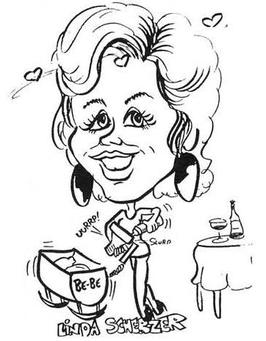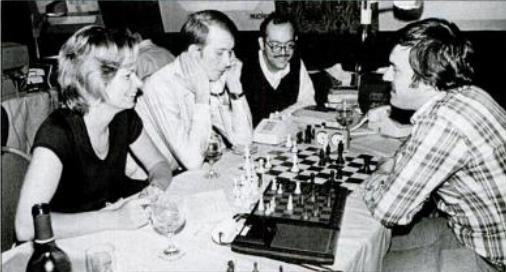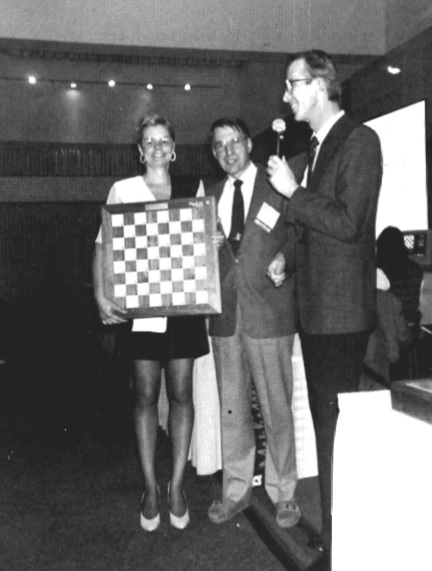Bebe
Bebe, (Be-Be)
a chess program running on a customized, special purpose bit slice hardware developed by Tony and Linda Scherzer as testbed for their company's SYS-10, Inc. mini- and mainframe processors [2] . It was originally written on a Z80 basis, as BB-1 already standby at the ACM 1978 [3] [4], and was ported to run on a SYS-10 computer [5] , based on AMD 2900 bit slicers [6] .
While the hardware did no longer improve significantly since the mid 80s, the software and opening book did. Bebe approached parallelism in generating attack and defend maps, move generation, move ordering, and evaluation, but otherwise had a serial search. Its implementation of Iterative deepening was quite unique. To avoid the odd-even effect, Bebe searched only odd depths with an increment of two plies at the root [7] . It further introduced a learning approach utilizing a persistent hash table, explained in award winning paper [8].
After Tony Scherzer's early death in January 1995 [9] , the work on Bebe discontinued, while SYS-10, Inc. continued, and is now a company providing custom software applications located in South Elgin, Illinois [10] , owned by Linda Scherzer since 1978 [11] .
Contents
Photos & Games
Linda and Tony Scherzer, Bob Henry and David Kittinger at ACM 1984, Bebe vs. Novag X [12]
[Event "ACM 1984"] [Site "San Francisco USA"] [Date "1984.10.09"] [Round "4"] [White "Bebe"] [Black "Novag"] [Result "1-0"] 1.e4 e5 2.Nf3 Nc6 3.Bb5 a6 4.Ba4 Nf6 5.O-O b5 6.Bb3 d6 7.Ng5 d5 8.exd5 Nd4 9.d6 Nxb3 10.dxc7 Qxc7 11.axb3 h6 12.Nf3 e4 13.Re1 Be7 14.Nc3 exf3 15.Nxb5 Qc5 16.Qxf3 Qxb5 17.Qxa8 Qb7 18.Qxb7 Bxb7 19.d4 Kd7 20.c4 Bb4 21.Re2 Rd8 22.d5 Nxd5 23.cxd5 Bxd5 24.Rxa6 Bxb3 25.Re4 Bc5 26.Be3 Kc7 27.Ra1 Bd5 28.Bf4+ Kc6 29.Rea4 Be6 30.Be5 Rd2 31.Bxg7 Bxf2+ 32.Kh1 Bd5 33.Bc3 Rc2 34.Ra6+ Kc7 35.R6a5 Kc6 36.Ra6+ Kc7 37.R6a5 Kc6 38.Ra8 Bb6 39.Rg8 f5 40.Rg6+ Kb5 41.Rd1 Be4 42.Bd2 Rxb2 43.Bxh6 f4 44.Rg5+ Kc6 45.Rc1+ Kd6 46.Bg7 Rf2 47.Rd1+ Kc6 48.Be5 Be3 49.Rg4 Bc2 50.Ra1 Kd5 51.Bb8 f3 52.gxf3 Rxf3 53.Ra5+ Ke6 54.h4 Bf5 55.Rga4 Kf7 56.Kg2 Rf2+ 57.Kg3 Rf1 58.Bf4 Bf2+ 59.Kg2 Bd3 60.Rd5 Be2 61.Rd7+ Kg6 62.h5+ Kxh5 63.Rd2 Bb6 64.Rxe2 Rg1+ 65.Kh2 Rb1 66.Rg2 Rb5 67.Ra6 Rf5 68.Kg3 Rf6 1-0
Achievements
Bebe was one of the strongest chess entities in the 80s. At its first appearance, the WCCC 1980 in Linz, it finished best placed "Micro" [13] . Four draws in four rounds, playing programs like Chess 4.9 and Nuchess. The following three World Computer Chess Championships were even more successful. Bebe was first runner up at the WCCC 1983 in New York, tied for first place at the WCCC 1986 in Cologne, and finally was runner up again in Edmonton at the WCCC 1989. As mentioned by Robert Hyatt, Bebe "helped" Cray Blitz to win both the WCCC 1983 and the WCCC 1986 [14] .
Bebe further played 13 consecutive ACM North American Computer Chess Championships, including the already mentioned WCCC in New York, from 1980 until 1993, again runner up in 1981 (tied), 1984 and 1985.
Selective Deepening
At ACM 1986, after winning ChipTest, Merlin and Recom, Bebe lost to Belle, the eventual winner. In the battle for the second place, Bebe was defeated by Lachex. Both programs went in a sequence of forced moves where both sides had only one single good choice along the way. Neither program had any idea about who would come up ahead in the end, until suddenly after playing along the forced line, both programs realized that Bebe was lost. In a discussion with Feng-hsiung Hsu and others, Tony Scherzer made the statement that the old idea of selective pruning was dead, replaced by the new idea of selective extensions . According to Hsu, that was how the idea of Singular Extensions began [15] .
[Event "ACM 1986"] [Site "Dallas USA"] [Date "1986.11.05"] [Round "5"] [White "Lachex"] [Black "Bebe"] [Result "1-0"] 1.e4 c5 2.c3 d5 3.exd5 Qxd5 4.d4 e6 5.Nf3 Nc6 6.Na3 Bd7 7.Bc4 Qe4+ 8.Qe2 Qxe2+ 9.Bxe2 cxd4 10.Nb5 O-O-O 11.cxd4 Bb4+ 12.Nc3 Be8 13.Be3 Nge7 14.O-O Ng6 15.Rad1 Kb8 16.a3 Bd6 17.d5 exd5 18.Rxd5 Nf4 19.Rxd6 Nxe2+ 20.Nxe2 Rxd6 21.Bf4 Kc8 22.Bxd6 Bd7 23.Rc1 Bg4 24.Ned4 Bxf3 25.gxf3 Kd7 26.Nxc6 bxc6 27.Rd1 Kc8 28.Bf4 Rd8 29.Rxd8+ Kxd8 30.b4 a6 31.Kf1 Ke7 32.Ke2 Ke6 33.Kd3 Kd5 34.Be3 g6 35.a4 h5 36.h4 f6 37.f4 f5 38.Bb6 Ke6 39.Kc4 Kd6 40.f3 1-0
Descriptions
1980
from the ACM 1980 booklet [16] : Tony Scherzer, SYS-10, Inc., Hoffman Estates, Illinois, Bebe Chess Machine on site (32K bytes, 16 bits, 6,250,000 inst/sec)
A relatively new program and machine, Bebe has recently acquired a provisional UCSF rating of 1810 based on play in one tournament. Bebe defeated an Expert in that tournament. Tony Scherzer's brainchild examines 10,000 nodes/sec or about 2,000,000 in a three minute move. The program is small, requiring only 10k 16 bit words. The program has no book. It uses iterative deepening and is written in assembly language.
1981-1986
- ACM 1981 [17] : Tony Scherzer, Hoffman Estates, Illinois, Bebe 25.000 Nodes/Sec
- WCCC 1983 [18] : Tony Scherzer, SYS-10 Inc., Hoffman Estates, Illinois, Bebe Chess Engine, 7 mips, 20K Nodes/Sec
- ACM 1984 [19] : Tony Scherzer, SYS-20 Inc., Hoffman Estates, Illinois, Bebe Chess Engine 20K Nodes/Sec
- ACM 1986 [20] : Tony Scherzer and Linda Scherzer, SYS-10 Inc., Hoffman Estates, Illinois, Bebe Chess Engine 40K Nodes/Sec
1989
from the WCCC 1989 booklet [21] :
Tony Scherzer and Linda Scherzer, SYS-10 Inc., Hoffman Estates, Illinois, Bebe Chess Engine, 40K Nodes/Sec
In early 1980 SYS-10 tried new hardware techniques needed for their mini/mainframe processor in co-processors for Bebe's CPU. Each co-processor takes over a specific function from the main CPU.
The first co-processor does the complete task of move list generation. The actual unit is divided into two processors which function in parallel: one that finds pieces and one that calculate and stores moves. This parallelism provides results more than 25 times faster than software.
A second co-processor performs the position scoring function. The scorer "looks at" the output of the move generator and uses the moves to calculate values for piece position mobility and co-operation. The scorer functions in parallel with the move generator.
Bebe operates at four distinct levels:
-
Software does I/O, timekeeping, book lookup, search depth control, and overall system control. -
Special CPU instructions do move list sorting, internal board update for making and unmaking moves, the alpha-beta minimax control, keeping track of killer moves, building bit maps of piece locations, and some board scoring functions. -
The co-processors perform move list generation, and some of the board scoring functions. -
The self-activated parallel processor determines of either king is in check and determines the attack-defender count for any square. Because it self starts, the answers for both kings are ready before the software can ask the question.
Mephisto Best-Publication Award
The fourth Mephisto Best-Publication Award for publications between April 01, 1990 and March 31, 1991 is awarded to Tony and Linda Scherzer and Dean Tjaden for their article Learning in Bebe published in Computers, Chess, and Cognition [22], explaining the implementation of a persistent hash table inside Bebe. The jury consisted of Jaap van den Herik, David Levy, Tony Marsland, Jonathan Schaeffer and Ken Thompson. The image by Jaap van den Herik from the Award giving ceremony during ACM 1991, November 20, 1991, Albuquerque, New Mexico, published in ICCA Journal, Vol. 14, No. 4 [23], the same issue also containes a condensed version of the paper [24] .
Linda Scherzer with the Award [25], ICCA representant Tony Marsland, and Tony Scherzer .
See also
Publications
- Editor (1979). Scuffle in a Corner. Personal Computing, Vol. 3, No. 8, pp. 76 » ACM 1978, Sargon
- Tony Scherzer (1979). Background on BB-1. Personal Computing, Vol. 3, No. 11, pp. 80
- Tony Scherzer, Linda Scherzer, Dean Tjaden (1990). Learning in Bebe. Computers, Chess, and Cognition » Mephisto Best-Publication Award
- Tony Scherzer, Linda Scherzer, Dean Tjaden (1991). Learning in Bebe. ICCA Journal, Vol. 14, No. 4
- Linda Scherzer (2020). BEBE, SYS-10, Inc., and computer chess. ICGA Journal, Vol. 42, Nos. 2-3
Forum Posts
- Machine Learning Experience by Mike Valvo, rgc, January 22, 1990
- Bebe and Belle by Joshua Lee, CCC, October 04, 1999 » Belle
External Links
Chess Program
Misc
- bebe - Wiktionary
- bebé - Wiktionary
- Bebe from Wikipedia (Disambiguation page)
- Astrud Gilberto - Água de Beber, 1965, YouTube Video
References
- ↑ Cartoon by Jeff Ragsdale from the ICCA Journal 1987, 1988 and 1989, reprinted in Kings Move - Welcome to the 1989 AGT World Computer Chess Championship. Edmonton, Alberta, Canada, Courtesy of Peter Jennings from The Computer History Museum, pdf
- ↑ Linda Scherzer (1984): "We justify this as our research and development department. We try out the firmware in Bebe, then design it for commercial products".
- ↑ Editor (1979). Scuffle in a Corner. Personal Computing, Vol. 3, No. 8, pp. 76 » ACM 1978, BB-1, Sargon
- ↑ Tony Scherzer (1979). Background on BB-1. Personal Computing, Vol. 3, No. 11, pp. 80
- ↑ SYS-10, not to be confused with the decimal Singer System-10
- ↑ Peggy Watt (1984). Mainframes checkmate Micros. InfoWorld, November 5, 1984, pp. 18, google books
- ↑ Odd ply versus even ply searches by Robert Hyatt, rgcc, February 28, 1996
- ↑ Tony Scherzer, Linda Scherzer, Dean Tjaden (1990). Learning in Bebe. Computers, Chess, and Cognition
- ↑ IGI Individual Record - Anthony Scherzer
- ↑ Welcome to SYS-10, Inc.
- ↑ Linda Scherzer (Shinouskis) - LinkedIn
- ↑ Peggy Watt (1984). Mainframes checkmate Micros. InfoWorld, November 5, 1984, pp. 18, google books
- ↑ Mikros noch ohne Großmeister-Format November 28, 1980, Computerwoche 48/1980 (German)
- ↑ Re: Who is the better chess program author? (more) by Robert Hyatt, CCC, December 13, 2001
- ↑ Feng-hsiung Hsu (2002). Behind Deep Blue: Building the Computer that Defeated the World Chess Champion, Princeton University Press, ISBN 0-691-09065-3, pp. 54-55
- ↑ The Eleventh ACM's North American Computer Chess Championship, pdf from The Computer History Museum
- ↑ The Twelfth ACM's North American Computer Chess Championship, pdf from The Computer History Museum
- ↑ The Fourth World Computer Chess Championship (labeled 22nd ACM), pdf from The Computer History Museum, pdf by Danny Kopec
- ↑ The Fifteenth ACM Computer Chess Championship, San Francisco California, October 7-9, 1984, pdf from The Computer History Museum
- ↑ The ACM's Seventeenth North American Computer Chess Championship and The Sixth World Microcomputer Chess Championship from The Computer History Museum, pdf
- ↑ Kings Move - Welcome to the 1989 AGT World Computer Chess Championship. Edmonton, Alberta, Canada, Courtesy of Peter Jennings, from The Computer History Museum, pdf
- ↑ Tony Scherzer, Linda Scherzer, Dean Tjaden (1990). Learning in Bebe. Computers, Chess, and Cognition
- ↑ The Board of ICCA (1991). The Mephisto Best-Publication Award. ICCA Journal, Vol. 14, No. 4, pp. 211
- ↑ Tony Scherzer, Linda Scherzer, Dean Tjaden (1991). Learning in Bebe. ICCA Journal, Vol. 14, No. 4
- ↑ Linda Scherzer with the Award (a Mephisto Vancouver ?)


